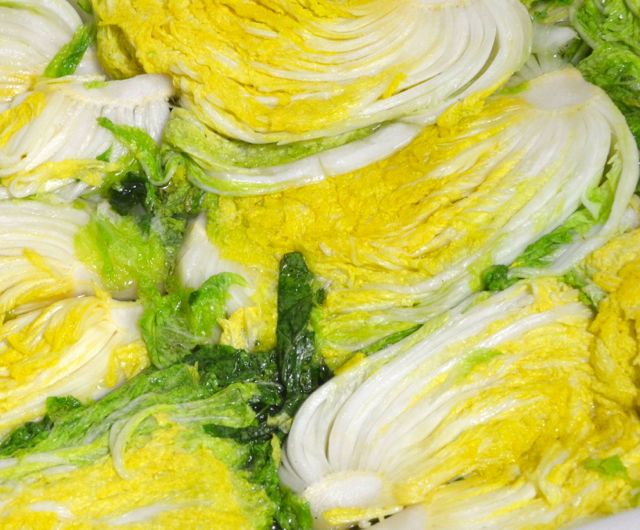
About this time last year I helped my mother-in-law’s Kimjang at her house and in return, I brought home couple containers of her yummy Kimjang. This year, I decided that it was time I tried it all on my own. I was a bit worried that I may not be able to handle the large amount of ingredients but hey, you have to take risks in life, right?
In late September, after my potato harvest, we planted Korean cabbages (배추 Baechoo), radishes (무우 Moo), Korean leeks (대파 Daepa) and mustard greens(갓 kaat) at our family farm for Kimjang.
After about 2 months, they were ready for picking. These pictures were taken around 11/20 or so. I came home with 16 cabbages, 9 radishes and a huge bunch of mustard greens. Also about two large bunches of Korean leeks. I bought the rest from the market.
Because I basically used the same Kimjang kimchi recipe from last year I will not list it again here. However, I will write more in depth about prep work- especially brining/salting cabbages. I know I mentioned in my last year’s post how most people just buy already brined cabbages (절임 배추 jeorim baechoo) because people say that’s the most difficult part of Kimjang both in terms of complexity and effort. You can use these tips for pickling cabbages in making regular small batch Kimchi at home.
How to brine (pickle) Korean napa cabbage (배추 baechoo) for Kimchi:
Ingredients
- 5 KOREAN NAPA CABBAGES (about 6 lb/2.7 kg each)
- 12 Cups or 5 lb/2.3 kg coarse SEA SALT (bitterns removed)
- 70 Cups/16.5 litre/17.5 qt cold or lukewarm WATER
- 1 gallon size bowl
- 1 giant container or bathtub to hold cabbages while they are brined
- 1 giant strainer/colander to drain brined cabbages
Directions
- Clean cabbage – Clean and cut away any outer leaves that are too damaged, brown or dirty. Most likely, your local market will sell already cleaned cabbages in which case need to do nothing. **Make sure you leave some good greenish outer leaves so you can use it to wrap the kimchi at the end.
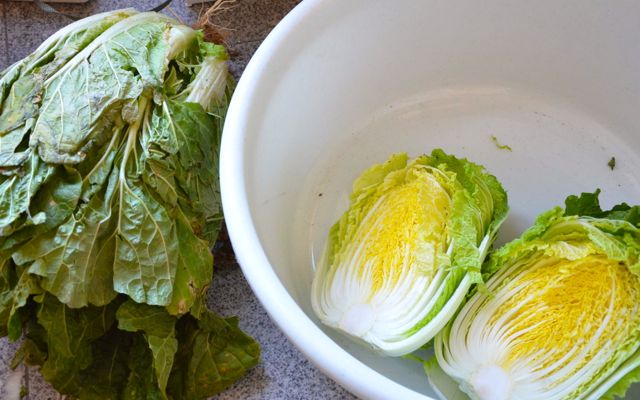
Cleaning cabbage for Kimjang kimchi Note how large the baechoo is on the left compared to the cleaned and cut ones on the right.
- Cut each cabbage in half. Tip for cutting cabbage for Kimchi: just cut about 1/3 of the bottom half (from the root end) and rip apart by hand. Like so –
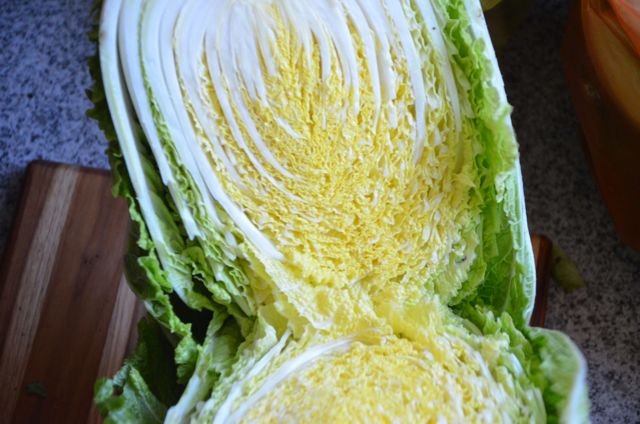
How to cut Kimjang cabbage baechoo in half It won’t be a huge disaster if you cut it all the way with a knife but it’s just easier this way and also you will not end up wasting cabbage pieces.
- In a large container, dissolve about 8 cups of salt and 17 1/2 quarts/70 Cups of cold or lukewarm water for the brine. Reserve remaining 4 cups salt for sprinkling. Please read my Kimjang tips post on discussion about salt. Solar sea salt is best if you can get them.
- Put cabbages in brine (made in step 3) – make sure the brine seeps fully into the cabbage by spreading out the leaves with your hands and swirling it around.
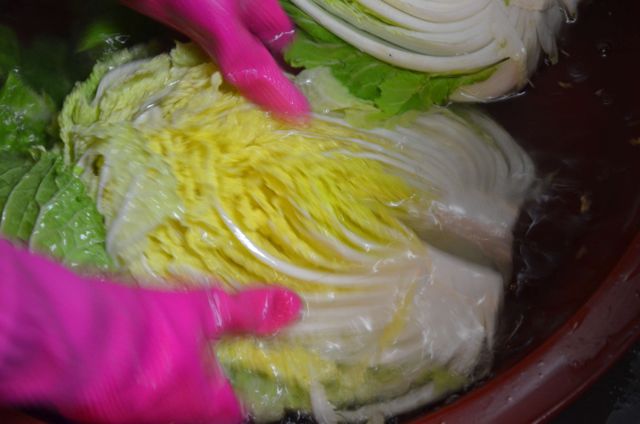
soaking cabbage in brine for Kimchi - Leave cabbages in brine for 2~3 hrs until the leaves start to get soft.
- When leaves are soft, For each 1/2 cabbage, REPEAT the following 3 steps:
-
- Take each cabbage out and let it drain for couple seconds and put in a bowl. DO NOT discard the brine because you will be putting cabbages back later on.
- Get a handful of salt from the remaining 4 cups and sprinkle (more like spraying) the salt in between leaves of each 1/2 cabbage, starting from the outer leaves. Aiming the salt mostly on the thick, white fleshy part of the cabbage.
- Put salted cabbages back into the brine.
-
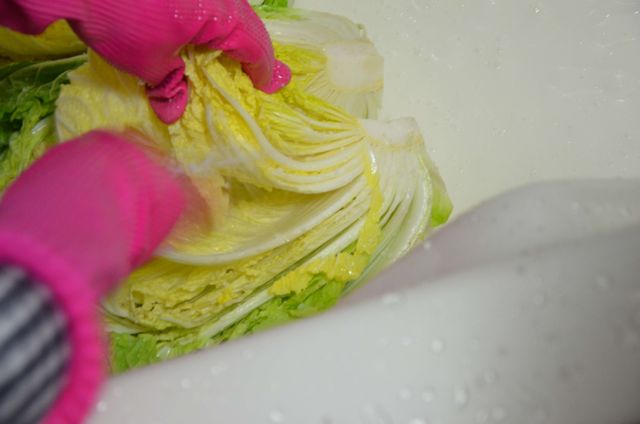
Salting cabbage for Kimchi ** We do this because the thick white fleshy part takes longer and more salt to pickle. You only need about 1/2 cup or less for each 1/2 cabbage. You may not need to do this if your cabbage has very thin white flesh or if you want to make your kimchi less salty.
7. Let cabbages sit in brine for another 10~12 hrs. Making sure cabbages are evenly pickled by rotating the ones on the top with the ones in the bottom, every 4 hrs or so.
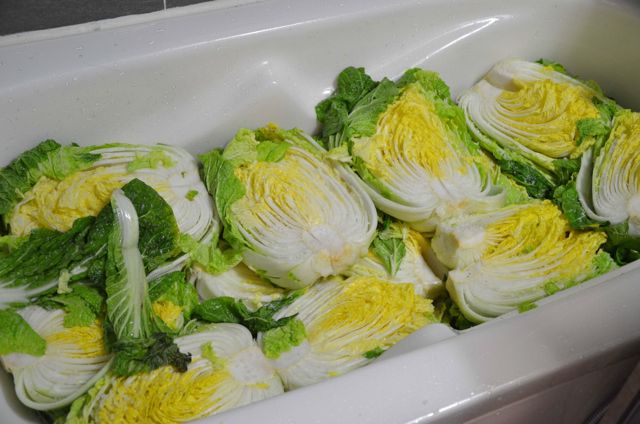
8. Next morning, the white part of the cabbage should be fully bendable like so-
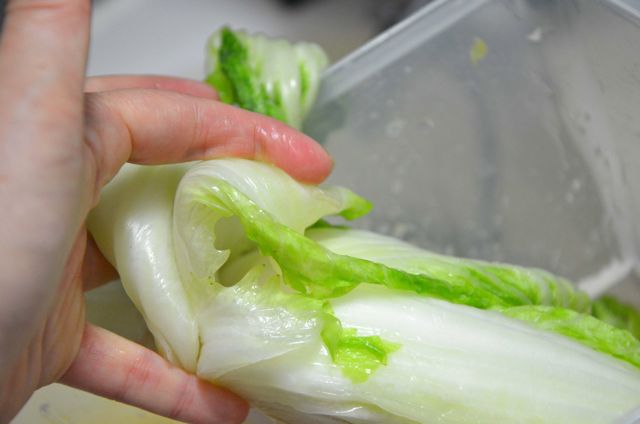
9. Rinse cabbages 3 times thoroughly. Let cabbages drain for 1 hr or so. Place the cut side down when draining.
Now you are ready to make the seasoning and finish up the Kimchi!
For the list of ingredients and recipe – see my post Kimjang Day: Part 1 – How it’s done.
For more info on ingredients and other tips – see my post Kimjang Day: Part 2 – Ingredients and Tips
Some Kimchi recipes tell you to brine cabbages for 6-8 hrs (at room temp) and this can work well for smaller batches (in fact, that’s what I do in my Easy Blender Kimchi) but traditionally, Kimjang cabbages were pickled overnight in cold winter weather.
In my opinion, brining overnight works better simply in terms of scheduling because you can start brining cabbages at night time and then finish making Kimjang kimchi the next morning. If you brine them for only 6-8 hrs, then you either end up making Kimchi at wee hours of the night or you end up starting the pickling process after midnight. None of which is fun..
So in my case, I washed and cleaned all the vegetables first during the day and then started pickling the baechoo (cabbage) in our bathtub around 7pm. Which meant I could rinse it around 8 am next morning.
Well, now you have it! With my tips on how to pickle/brine Korean cabbages for Kimchi, you should be able to make a very delicious Kimchi anytime!
About the BRINE:
- Pickling in 15% salt solution is the traditional standard for Kimchi cabbages. A recent trend is to make it less salty and many Koreans now pickle at 10~12 % salt solution. e.g. If you want to make a 10 cup brine solution, you can mix 8 1/2 C of water and 1 1/2 C salt. This is not an exact formula for making 15% but that’s what many people use to make things simpler and quicker. In this level of salinity, you will only need to pickle the cabbages in 6-8 hrs.
- Interestingly, in some coastal areas, Koreans pickle their cabbages in sea water instead of making a brine. Note, sea water’s salinity is around 3.5% to 4% which is much lower salinity than our brine so you will need to leave the cabbages much longer – usually a full 24hrs or longer.
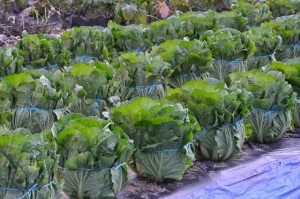
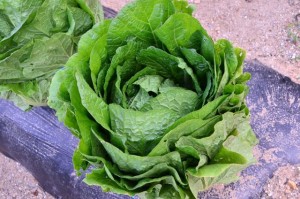
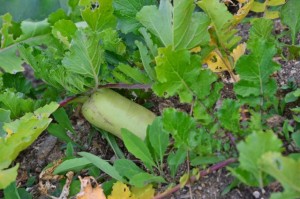
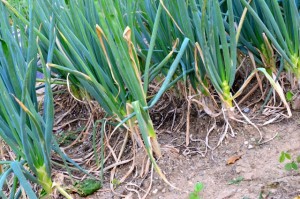
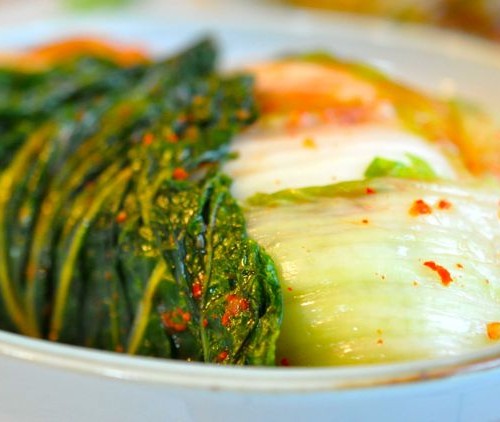
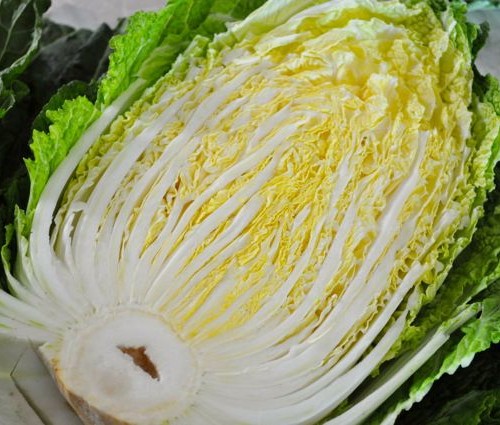

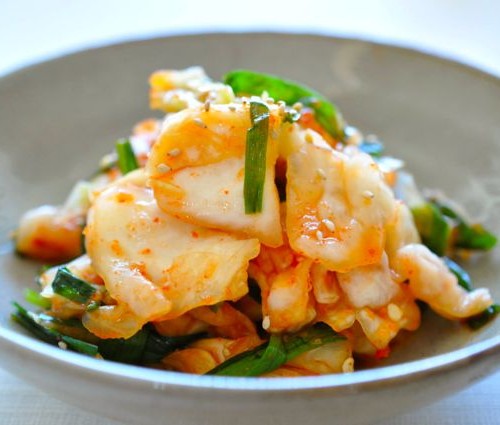
















Hi
I have made my first batch of Kimchi. A recipe I used said to top up with brine to cover the veg. However there is a lot of brine. If I push to veg down I have about 3 inches of brine above the veg. Is this ok and do I just leave all the veg in the brine ?
Thank you
What kind of recipe are you using? Is this an authentic Korean Kimchi recipe? Also, is it cabbage, radish..? It kind of depends but mainly it is important that the vegetables stay covered in kimchi seasoning liquid or brine so you should have enough liquid to do that. I don’t think you need all the brine as long as it’s covered. Normally, unless you are making water kimchi, Korean recipes will not produce so much brine that you have 3 inches extra.. so I’m kind of confused…let me know more and I can try to help further. Thanks for asking!
Hello JinJoo, thank you for sharing your method with us. I made a batch of Kimchi two days ago with other method, BUT now that I found you, I’ll try your method with my October Cabbage harvest. However I have some questions: what does “bitterns removed” from (Sea Salt) mean? Is there anything bitter in my salt? My salt is Korean sea salt meant or Kimchi. My Kimchi has always a bit bitter taste, someone told me ginger makes it taste bitter, so this time I put very little ginger, when I taste it before refrigerating it, I could taste the ginger! (kimchi still in crazy face) and it was bitter! I tasted the thick part of the leaves and it was not that good, but the soft part was tasting amazing, only I had if it had little juice attached to it, because the juice tasted a bit bitter. Maybe because I tasted the part on top and that get bitter because of oxygen exposure? When in the brine, the leaves wilted very fast, 3 hours, and I was afraid they were far too long in salt, is that because the cabbage is a summer harvest maybe? Thank you soooooooo much and I’ll update my Kimchi status.
Hi Liz, Thank you so much for appreciating my posts and for asking questions! Fresh solar sea salt contain some amount of sea water which has some bitterness in them. Koreans age the sea salt while letting the bitter sea water drain away which then becomes “salt with bitterns removed’. Please read https://kimchimari.com/kimjang-day-part-2-ingredients-and-tips/, SALT section to learn about “bitterns removed”. Bitter salt can definitely make your Kimchi bitter. If your Kimchi is always bitter, perhaps it is the salt that is causing it. If it’s good quality Korean sea salt, it should have been aged 3 years or more with the bitterness removed but sometimes, you get Chinese sea salt resold as Korean which is not good. No, oxygen exposure should not cause any bitterness. Hmm..summer cabbages are not as sweet and crunchy as fall cabbages but not sure if they would be bitter. Best thing to do is to taste your salt by itself, do you taste any bitter aftertaste? Let me know how it turns out. Good luck!
Hi JinJoo
Thanks for all of this effort for Kimchi… It is REALLY appraciated
Trying your method of brining halfs instead of chopping prior…
I’m looking for salt to bring ratio using this post as you have been kind enough to give grams and litres as that’s what I use here in Ireland
I divided the above salt to water ratio and got 130mg to 1 litres.. Which is way to much.. (I think)
Can you help me please with this ration
Thank you
Hi Ben,
Thanks so much for asking. So if talking about the total amount of salt added to the brine (eventually) then, yes, you are correct, the recipe I have does come out to 130g (not mg) to 1 litre. I know that seems like a lot but that’s how it has been done traditionally by our mothers for many years. More modern recipes use reduced amount of salt (as much as down to 1/2 the amount of salt) and if you want to do that you are welcome to try. BTW, remember you are sprinkling 6 cups of the salt in between cabbage leaves which does not all dissolve into the water. And even if it does, brining cabbages is all a bit different based on your salt, thickness of the cabbage and how long you leave in there. Less salty brine, you will want to leave the cabbages longer, more salty brine, you will be taking the cabbages out sooner.
Also, this ratio is for Kimjang cabbages which in the old days, you want to make it fully pickled so they will last throughout the winter into spring. Many just make smaller batches and keep in fridge so you are totally welcome to reduce the amount of salt. Just make sure, you sprinkle well in between the thick part of the leaves and also test the doneness using my test with the white part of the leaves. Also, if you feel that the cabbage is too salty for your taste after it is brined, you can always adjust the seasoning and add less salt to that. It all balances out in the end.
Last thing, I want to make sure – you are using Korean solar sea salt (cheonilyeom), correct? If you are using some other coarse sea salt or pickling salt, it can be too salty since Korean solar sea salt is less saltier than most.
Thank you so much for asking in a gentle way. :)) I really appreciate that. Asking instead of judging…I think I will try to write in some additional notes based on your feedback.
Hi! Kimchi in the stage of fermentation, i realised that it is too spicy. Can I add brine napa cabbage to reduce the spicyness.
Hi there! I’m wondering if you can leave the cabbage in the brine for too long? Mine’s been soaking in salt water for two days now… Should I start again, or just rinse the cabbage more? Thank you!
Hi! So sorry for the late reply – I was coming back from a trip yesterday. Oh dear..2 days..or I guess now 3 days?? how does the cabbage look like? If you are not in a warm weather, it may be OK – as long as the cabbage is not mushy anywhere. Actually, it will be less crunchy the longer you brine it. Recently in Korea, they sell pickled (brined) but rinsed cabbage which may end up being in that state for few days so it may be not too bad. But sitting in the salt water that long, you will lose a lot of the flavor and crunchiness. It may not be the most ideal way but yes, just rinse it more and taste it. You may even want to leave it in plain water for a few minutes and you may get reverse osmosis. But then you are risking the cabbage getting mushy later on. If it’s still crunchy and not too salty, you can try making with it still. Sorry, I don’t have a definite answer but hopefully this was not too late!! Let me know if you have more questions.